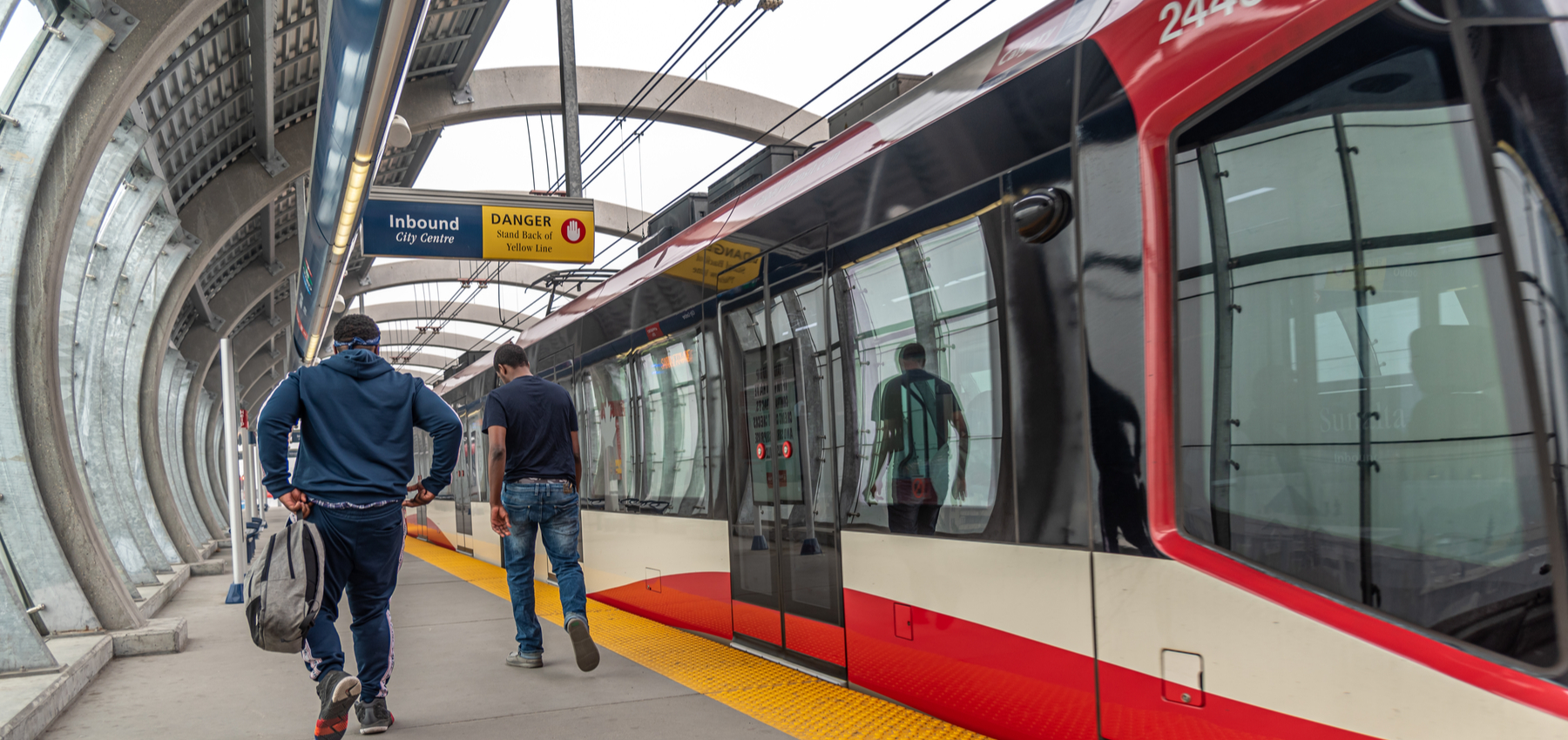The multicultural city of Calgary welcomes thousands of newcomers each year. One of your first priorities as a newcomer is to understand how to get around your new city. Calgary’s frequent and inexpensive public transportation system is a convenient way to travel while cutting down on car costs and reducing your personal carbon footprint.
Tip: For an introduction to the city of Calgary in the Canadian province of Alberta, see the provincial spotlight on Alberta.
Calgary’s new transit innovations, such as the My Fare app for contactless payment, make its transit system advanced and user-friendly. The main public transit authority in Calgary is called Calgary Transit. See Calgary Transit’s full Rider’s Guide for even more tips for first-time transit riders in Calgary.
How do you get around in Calgary?
The city of Calgary can be easily navigated through its multiple forms of public transportation. By combining buses and rapid-transit with cycling and short car trips, all new Calgary residents can use public transit to reach their destinations with ease.
1. Buses
The city of Calgary operates over 160 bus routes to get you where you need to go in the city. Most bus stops are marked with large white signs displaying their route number, as well as a small shelter. You can pay with cash, the MyFare app, or a monthly pass card at the front door of the bus.
2. Ctrain
The Ctrain is Calgary’s rapid transit service, which runs two lines across the city. The Red Line runs north-south from Crowfoot to Somerset-Bridlewood, and the Blue Line runs east-west from Saddletown to 69 Street. There are plans for extensions of existing lines, as well as entirely new Ctrain lines, which you can keep up to speed on by following the RouteAhead plan.
3. Cycling
Calgary’s cycling network is constantly being improved to support this environmentally friendly and healthy form of transportation. You can combine cycling with the use of the bus or Ctrain easily to cover longer distances:
- Ctrain stations: Most Ctrain stations have bike racks to store your bike while you ride, as well as paid bike lockers, which cost $132 CAD per year. You can also bring your bike on the Ctrain at any time except weekday rush hour (6:30 a.m. to 9 a.m. and 3 p.m. to 6 p.m.) when the Ctrain tends to be quite full.
- Bikes on buses: Bike racks are fitted onto many vehicles in Calgary’s bus fleet. To learn how to use these bike racks, see Calgary Transit’s walkthrough of the process. Routes 1, 9, 14, 20, 38, 43, and Max Teal have bike racks on buses every day of the week. See more about bike rack specifications to ensure your bike will fit on the bike rack, which is attached to the front of the bus.
- Lime Bike Share: Using the Lime app, you can rent electric bikes all over Calgary. The cost is $1 CAD to unlock the bike, plus $0.30 CAD for every minute you ride. See the Lime site for more information on picking up and parking Lime bikes.
Tip: Know Calgary’s bicycle safety rules before you start biking on the road.
4. Park and ride
If you don’t live close to the Ctrain station, but still want to make the most of this service, you can park your car at a Ctrain station and then ride the rest of the way to your destination. This will help you avoid Calgary’s famously high downtown parking rates. You can reserve a spot ahead of time, or book one on a monthly basis for a fee of $85 CAD.
Types of fares: The best ways to pay for public transit in Calgary
Where to buy transit passes in Calgary
There are a few options of locations to buy your transit pass or tickets in Calgary:
- Customer Service Centre
- City Hall Cashiers
- My Fare app
- Visit Calgary Transit online
- Various convenience stores and grocery stores that sell Calgary Transit fare products
How much is transit fare in Calgary?
You can pay cash fares for one-way travel, which are valid for 90 min to include time for ride transfers. Adult fare is $3.50 CAD, with discounts for children and students.
Day passes, and monthly passes can be purchased and loaded onto a monthly pass card or the My Fare app. An adult monthly pass costs $109 CAD as of July 2020.
Tip: Starting this year, Calgary has brought in the My Fare app with touchless payment. Riders are able to buy their passes and pay for Ctrain using the tap function and have the app scanned on Calgary buses. Transfers will still be valid for 90 minutes to switch to another form of transit, but there will be no need for a paper transfer or physical ticket.
Low income and discount passes
If you need financial support for a monthly transit pass, you may qualify for the Calgary Fair Entry program. See if you qualify for this assistance, which also covers recreation fees, property tax assistance, and more.
University students in Calgary qualify for the UPass program, which allows a heavily discounted transit rate, which is paid in conjunction with student fees.
Seniors over 65 can also receive a discount if they purchase a senior yearly pass and provide photo ID confirming their age.
How to plan your Calgary transit trip
Where to find Calgary public transit maps
Before setting out on public transit in Calgary, you can first familiarize yourself with the city’s transit maps:
- Calgary Transit system map
- Ctrain system map
- LRT Station and Bus Terminal maps
- Airport Service Routes
- School Express Routes
Using trip planning tools
By inputting your point of departure and destination, you can get your optimal transit route calculated with a trip planning tool. Try out the Calgary Transit planning tool to see how it works. Trip planning tools often give you multiple route options, so you can pick which route will work the best for you, and determine your route on the fly with the Calgary Transit app.
Tip: Rocketman is a Canadian-built transit app that you can use to find out when the next bus or train is arriving, track your bus along its route, save your favourite stops, and get transit delay alerts in real-time. You can download the Rocketman app today for free.
Rocketman is easy to use, showing you only the info you need to get you to your destination on time and with minimal waiting. Riders using the app can even see how full each transit vehicle is before boarding with the Crowdedness feature. This feature works by asking commuters to help other riders by reporting how crowded their transit vehicle is, and the app can display these crowdedness levels so all Rocketman users can be better prepared for their commute.
Benefits of using public transportation in Calgary
Save money on vehicle costs
Driving a car comes with many additional costs beyond initial purchase or monthly lease; gas, maintenance, insurance, and parking add up quickly. Taking transit can save you plenty of personal money in the long run, as well as cutting down on the city’s costs of building car infrastructures like highways and parking lots.
Tip: See the City of Calgary’s trip cost calculation tool to see how much each form of transportation actually costs your community, based on the distance you travel.
Environmental benefits
Public transportation in a large city like Calgary is a great choice for new residents for convenience, but did you know that choosing public transit over a personal vehicle is also a great choice for the environment? Reducing your greenhouse gas emissions by choosing transit is one of the most effective ways to minimize your personal carbon footprint.
Tip: You can measure your potential carbon footprint in Canada using Natural Resources Canada’s Greenhouse Gas Equivalencies tool.
Support a more active lifestyle
Adding more activity to your daily routine is one of the best ways to consistently support your health. Using public transit requires more walking and active participation than driving directly to your destination. Add even more daily activity by combining your commute with cycling.
Now that you have been introduced to the public transportation system in Calgary, travelling around the city will be no problem. You can use maps or trip planning tools to map out your route, and easily pay your transit fares right from your phone on the My Fare app. Calgary’s transit system continues to be innovated to serve the community to provide even better services so you can get to your destination with minimal cost, time, and environmental impact.




